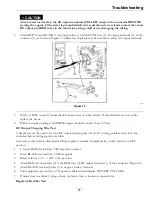
Safety
Transporting
Note:
Refer to the chemical warning product
label(s) before transporting the unit and follow all
local/state/federal requirements for transporting
chemicals.
Note:
Make sure the spreader hopper cover is secure
before transporting.
Transporting a Unit
Use a heavy-duty trailer or truck to transport the
machine. Lock brake and block wheels. Be sure the
fuel shut-off valve is closed during transport. Securely
fasten the machine to the trailer or truck with straps,
chains, cable, or ropes. When securing the front of
the unit, only use the tie down locations. If possible,
both front and rear straps should be directed down
and outward from the machine. Be sure that the
trailer or truck has all necessary lighting and marking
as required by law. Secure a trailer with a safety chain.
WARNING
Securing the machine on any upper frame
location will cause the parking brake to not
function properly, which could cause serious
injury or death.
Only use the front tie down locations on the
lower frame to secure the machine.
CAUTION
This machine does not have proper turn signals,
lights, reflective markings, or a slow moving
vehicle emblem. Driving on a street or roadway
without such equipment is dangerous and
can lead to accidents causing personal injury.
Driving on a street or roadway without such
equipment may also be a violation of State laws
and the operator may be subject to traffic tickets
and/or fines.
Do Not drive a machine on a public street or
roadway.
WARNING
Loading a machine on a trailer or truck increases
the possibility of backward tip-over. Backward
tip-over could cause serious injury or death.
•
Use extreme caution when operating a
machine on a ramp.
•
Use only a single, full width ramp; Do Not use
individual ramps for each side of the machine.
•
If individual ramps must be used, use enough
ramps to create an unbroken ramp surface
wider than the machine.
•
Avoid sudden acceleration while driving
machine up a ramp to avoid tipping backward.
•
Avoid sudden deceleration while backing
machine down a ramp to avoid tipping
backward.
Loading a Machine
Use extreme caution when loading machines on
trailers or trucks. One full width ramp that is
wide enough to extend beyond the rear tires is
recommended instead of individual ramps for each
side of the machine. If it is not possible to use one
full width ramp, use enough individual ramps to
simulate a full width continuous ramp.
A steep ramp angle may cause components to get
caught as the machine moves from ramp to trailer or
truck. Steeper angles may also cause the machine to
tip backward. If loading on or near a slope, position
the trailer or truck so it is on the down side of the
slope and the ramps extends up the slope. This will
minimize the ramp angle. The trailer or truck should
be as level as possible.
Important:
Do Not attempt to turn the machine
while on the ramp, you may lose control and
drive off the side.
Avoid sudden acceleration when driving up a ramp
and sudden deceleration when backing down a
ramp. Both maneuvers can cause the machine to tip
backward.
Waste Disposal
Chemical Disposal:
Improper chemical disposal
can pollute the environment and cause health issues.
Follow the disposal directions on the chemical
manufacturer’s label. Dispose of chemicals and
containers in accordance to local/state/federal laws.
10











































